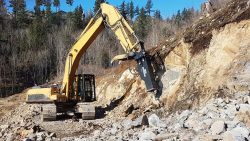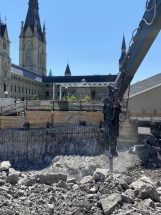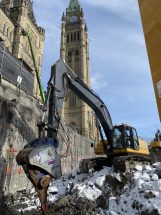Xcentric Ripper vs. Hydraulic Hammer: Which Attachment Performs Best in Frozen Ground & Hard Rock?
When winter hits or when you’re working in hard material, choosing the right excavator attachment can make or break your production. In Canada, crews often rely on hydraulic hammers to break frost, shale, and hard rock — but over the last decade, the Xcentric Ripper has become a highly effective alternative, especially in dense, frozen ground, and many types of rock formations.
If you’re trying to decide which tool is right for your job, here’s a clear breakdown of how hydraulic hammers and the Xcentric Ripper compare in real-world performance.
What Is a Hydraulic Hammer?
A hydraulic hammer (or breaker) uses high-impact, repetitive blows to fracture material. They’re widely used, familiar to operators, and effective in a range of conditions, including concrete, boulders, and demolition applications.
Strengths:
• Precise breaking
• Works well in tight areas
• Strong for vertical applications (foundations, concrete, stationary rock)
• Familiar to most operators
• Good for small, controlled breaking jobs
Limitations in winter & hard rock:
• Slower production in thick frost and permafrost
• High wear on bushings, tool steel, and seals if greasing intervals and proper 90-degree breaking techniques aren’t followed
• Heat buildup in oil during continuous hammering
•Higher vibration is transmitted to the machine and operator compared to the XR
•Breakers cannot pry or rip material — doing so damages the tool and slows production
• Increase wearables compared to an XR
What Is the Xcentric Ripper?
The Xcentric Ripper uses a patented Impact Vibration Accumulation technology. Instead of delivering small hammer blows, it applies large, continuous impacts using a high-frequency eccentric system — essentially “ripping” the material apart, driving the XR’s shank into the ground.
Strengths:
• Exceptional performance in frozen ground, shale, limestone, and many types of rock formations
• Up to 5× faster production than hydraulic hammers in many conditions
• Lower fuel consumption
• Significantly less vibration for the operator and the machine
• Reduced wear parts and maintenance
• Ideal for deep trenching, large excavations, and high-volume material removal
Limitations:
• Not ideal for very dense, unfractured solid granite
• Requires material to have natural fracture planes if the rock is harder in nature
• Not designed for precise “spot breaking” like a hammer
Performance Comparison
1. Speed & Productivity
Winner: Xcentric Ripper
In frost, fractured rock, shale, or permafrost, Xcentric Ripper units typically remove material much faster because they can stay in the cut continuously without overheating or losing impact power.
2. Fuel Efficiency
Winner: Xcentric Ripper
Rippers require lower hydraulic flow and maintain steady production without the full-power cycles that hammers need. Many operators report 20–30% less fuel consumption.
3. Operator Comfort & Vibration
Winner: Xcentric Ripper
The XR’s vibration system, consisting of an air bag much like you’d see on a semi truck, isolates most of that shock, improving operator comfort and reducing long-term fatigue.
4. Machine Wear
Winner: Xcentric Ripper
Hammers are hard on pins, bushings, and boom structures. The XR’s motion is smoother and transfers significantly less force into the excavator.
5. Maintenance
Winner: Xcentric Ripper
Hydraulic hammers require frequent tool changes, bushing greasing, and monitoring of nitrogen levels. The XR has fewer wear components and longer service intervals.
6. Precision Breaking
Winner: Hydraulic Hammer
If you need small, controlled, high-precision breaking (e.g., concrete pads, large boulders, detailed demolition), a hammer still performs better.
When to Choose a Hydraulic Hammer
A hammer might be the better choice if your job involves:
• Breaking very large, solid boulders
•Extremely dense, unfractured rock where natural fracture planes do not exist
• Precise demolition work
• Concrete structures
• Tight access areas requiring pinpoint accuracy
When to Choose an Xcentric Ripper
An XR will outperform a hammer when you’re working in:
• Deep frost or permafrost
• Hard-packed clay
• Shale
• Limestone with fracture planes
• Basalt layers with natural weaknesses
• Layered rock formations
• Trenching over long, continuous runs
• Jobs where production speed is critical
It’s especially effective for contractors who want to increase daily output, reduce machine strain, and lower fuel costs while working in tough Canadian ground conditions.
Which One Is Best for You?
In Canadian winter and most rock applications, the Xcentric Ripper delivers better production, lower operating costs, and less downtime than a hydraulic hammer. Many contractors who switch to the XR find that it not only outperforms traditional breakers — it also replaces the need for blasting in some cases.
But both tools have their place depending on material type, job requirements, and operator preference.
If you want help determining the right attachment for your next job, our team can walk you through the options and recommend the ideal model for your excavator size and material conditions.





